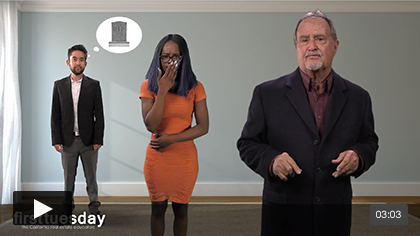Inverse condemnation award for forced conditions
A developer was issued a tentative tract map by the city’s planning commission and permits were issued for the construction of a shopping center on the property. When construction was well underway, a city official, empowered to issue the final map, informed the developer that a final map would not be issued unless the developer granted an easement to a privately-owned utility company for the addition of communication cable access to the property, the performance of extensive trench work to lay the cable and paid an additional permit fee. Having no economically feasible alternative to compliance due to lease commitments to tenants and construction loan obligations to the lender, the developer complied with the official’s demands. On completion of the shopping center, the official issued the final map and certificate of occupancy. The developer then made a demand on the city to compensate him for the loss of property to the easement and for related expenses under inverse condemnation, claiming the requirement of the easement grant as a condition for approval of the final map was a taking since the condition was an administrative decision, not an advisory agency’s original condition set for approval of the tentative map. The city claimed the developer could not seek compensation under inverse condemnation since the additional requirements for final map approval constituted a change in conditions imposed by the tentative tract map which must be challenged within 90 days. A California appeals court held the developer was entitled to compensation under an inverse condemnation action when filed within five years of the taking since the city official’s added requirements for issuance of the final map were an administrative threat, not conditions imposed by the planning commission in the original tentative tract map, in which case the developer would have been barred by the 90-day statute of limitations for challenging conditions in a tentative tract map. [Uniwill L.P. v. City of Los Angeles (November 30, 2004) 124 CA4th 537]
Condemned property valued on date compensation deposited
A college began a quick take eminent domain action against a landowner. The college deposited with the landowner an amount of compensation probably due him based on the appraised value of the property on the date of the deposit. The college took possession of the property. The landowner sought a higher amount of compensation, claiming the date of valuation of the property should be the date on which the trial court determines the just compensation he is entitled to since the property’s value has substantially increased after the date of the probable compensation deposit. The college claimed the date of valuation should be the date of deposit of the probable compensation as required by state law. A California appeals court held the date of valuation of the property on a taking by eminent domain was the date the college deposited the probable compensation with the landowner since the taking occurred on the date the deposit was made, and a greater award of compensation based on later market fluctuations would be unjust to the college. [Mt. San Jacinto Community College District v. The Superior Court of the County of Riverside (February 4, 2005) __ CA4th __]
Partial palm and pylon obstruction not a taking
A city planted palm trees and placed lighted pylons in the median and along one side of a street as part of an enhancement project. An advertising company owned several billboards which were partially obstructed by the palms and pylons that lined the street. The advertising company sought compensation, claiming the loss of billboard visibility was a taking for which it must be compensated. The city claimed the advertising company was not entitled to compensation since the planting of the palms and placement of pylons was not a taking affecting the advertising company’s property rights. A California appeals court held the advertising company was not entitled to compensation since a takings claim based solely on the loss of visibility of billboards is not a substantial impairment of an owner’s property rights. [Regency Outdoor Advertising, Inc. v. City of Los Angeles (February 17, 2005) __ CA4th __]
Editor’s note — The court likened the loss of business value due to a loss of visibility to a loss in business value due to highway changes which do not interfere with business access, neither of which is compensable. [Goycoolea v. City of Los Angeles (1962) 207 CA2d 729]
Power to take property hinges on public use
A city approved a redevelopment project designed to rejuvenate its distressed economy. The city exercised its power of eminent domain and began condemnation proceedings to take properties located within the redevelopment project. A property owner sought to stop the city from taking his property, claiming the taking violated the public use restriction in the Fifth Amendment’s Takings Clause since the city’s sole basis for the taking was economic development, not because his property was blighted or in poor condition. The city claimed the taking did not violate the public use restriction since the project was for economic development that would benefit the public. The United States Supreme Court held the taking of the owner’s property did not violate the public use restriction in the Fifth Amendment since the taking was necessary for an economic governmental project designed to serve the public purpose of promoting economic development for the entire community, not limited to benefitting a particular class of individuals. [Kelo v. New London (June 23, 2005) 545 US __]
Editor’s Note — In the event of a forced sale, the property owner is entitled to just compensation which fully reimburses the owner at fair market value for the loss of his property and for relocation.
Non-principal residency not protected from rent increase
A city with rent control ordinances enacted an occupancy ordinance allowing landlords to increase the rent on an unit occupied by a tenant who does not use the unit as his principal residence. A landlord petitioned the rent control board for an increase in the rent he could charge an existing tenant claiming the tenant did not occupy the unit as his principal residence. The rent control board approved the rent increase. The tenant claimed the rent increase was unenforceable since the rent control board exceeded its authority when it approved the occupancy ordinance. The rent control board claimed the rent increase was valid since the tenant used the unit for other than his principal residence. A California appeals court held the rent control board did not exceed its authority in adopting the occupancy ordinance since the purpose of the ordinance was to provide protection to tenants who occupied rent-controlled units as their principal residence, not tenants using rent-controlled units for other purposes. [Bisno v. Santa Monica Rent Control Board (June 28, 2005) __CA4th__]
Unrecorded titleholder denied excess tax sale proceeds
A purchaser of property at a trustee’s sale did not record the trustee’s deed conveyance or pay property taxes. Ultimately, the property was sold at a tax sale which generated proceeds in excess of the unpaid property taxes. The purchaser claimed he was entitled to the excess proceeds from the tax sale since he was the owner of the property under the unrecorded deed. The county claimed the purchaser was not entitled to the excess proceeds since, as a holder of an unrecorded title, he was not a party of interest in the property entitled to any excess proceeds. A California appeals court held the owner was not entitled to the excess sales proceeds since the owner of an unrecorded title of property was not a party of interest. [Azadozy v. Nikoghosian (May 4, 2005) 128 CA4th 1369]
Editor’s note — A party of interest for distribution of excess proceeds from a tax sale of a property is first, a lienholder, and second, any person with title of record to the property prior to the tax sale.
Thus, the owner who lost his property to foreclosure is entitled to the proceeds in the Azadozy case since he remained of record as the owner at the time of the tax sale.
Rain-induced landslide losses not covered
A homeowner’s hazard insurance policy excluded coverage for losses caused by landslides. Weather conditions were a covered peril unless they contributed to a peril excluded from coverage, such as a landslide. After heavy rains, the homeowner’s residence was damaged by a landslide triggered by the rains. The homeowner tendered a claim under his insurance policy for weather-related losses, claiming state law imposes liability on an insurance carrier for losses if the primary cause of the loss is covered under the insurance policy. The insurance carrier denied the claims, claiming the losses were not covered since the landslide was the primary cause of the loss and weather conditions were only a remote cause. The California Supreme Court held the homeowner’s losses were not covered since the landslide was the primary cause of the loss, not the weather which brought about the landslide, and the landslide was a peril excluded from coverage. [Julian v. Hartford Underwriters Insurance Company (May 5, 2005) 35 C4th 747]
Coastal Commission unable to affect development outside coastal zone
A developer applied to the California Coastal Commission (CCC) for a permit to develop that portion of his land located within the coastal zone. The entire development impacted the scenic views and environmentally sensitive habitat areas inside the coastal zone. An environmental impact report found the impact created by the development located within the coastal zone could be fully mitigated. The permit was approved by the CCC. An environmental group sought to stop the construction, claiming the CCC improperly approved the developer’s permit since the CCC was required under the California Coastal Act of 1976 (Coastal Act) to deny a permit when the development was on property both inside and outside the coastal zone if the development outside the coastal zone could produce adverse environmental effects within the coastal zone. The CCC claimed it properly approved the permit since the Coastal Act required it to grant a permit for development within a coastal zone when the environmental impacts created by that portion of the development have been mitigated since to deny the permit due to impacts from outside the zone would indirectly regulate development outside the coastal zone. The California Supreme Court held the CCC properly approved the permit since the development on property located outside the coastal zone was not subject to coastal development permit requirements and the CCC had no authority to deny a permit if development inside the coastal zone conformed with the Coastal Act. [Sierra Club v. California Coastal Commission (May 19, 2005) 35 C4th 839]
Separate property not transmuted by conveyance to living trust
A husband and wife established an intervivos (living) trust. A clause in the trust agreement stated any property received by the trust was community property unless identified as separate property. The husband transferred separate property to the trust but did not identify the property as his separate property. Later, the husband and wife divorced. The wife then sought a one-half ownership interest in the separate property her husband transferred into the trust, claiming the clause in the trust agreement transmuted the husband’s separate property to community property since the husband did not identify the property as his separate property. The husband claimed the clause in the trust agreement was insufficient to transmute his separate property to community property since he did not declare in any writing his separate property was community property. A California appeals court held the clause in the trust agreement did not operate to transmute the husband’s separate property to community property since neither the trust agreement nor the conveyance stated their purpose was to change separate property into community property. [In re Marriage of Starkman (May 18, 2005) 129 CA4th 659]

















